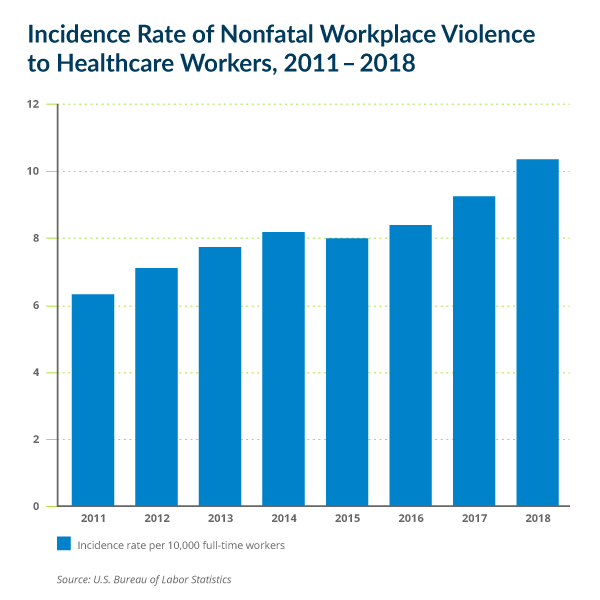New Prevention Standards Regarding Violence Against Healthcare Workers
Effective standards, policies, and protocols signify both the responsible acknowledgment of an existing issue and a well-reasoned course of action seeking to improve it. Accordingly, as of January 1, 2022, new standards issued by The Joint Commission (TJC) require hospitals to provide training, education, and resources to address the prevention, recognition, response, and reporting of workplace violence.1
Each TJC-accredited hospital has latitude in determining which aspects of training are appropriate for its own leadership, staff, and licensed practitioners based on the individual’s roles and responsibilities.1 As detailed in Standard HR.01.05.03 / EP 29, the training mentioned above addresses:1
- What constitutes workplace violence
- Education on the roles and responsibilities of leadership, clinical staff, security personnel, and external law enforcement
- Training in de-escalation, nonphysical intervention skills, physical intervention techniques, and response to emergency incidents
- The reporting process for workplace violence incidents
Now let’s look at why new standards, policies, and protocols for preventing violence in the healthcare environment have become a necessity.
A Troubling Trend
The Occupational Safety and Health Organization (OSHA) defines workplace violence as “any act or threat of physical violence, harassment, intimidation, or other threatening disruptive behavior that occurs at the work site.”2 OSHA suggests healthcare employers establish a zero-tolerance policy toward workplace violence covering all workers, patients, clients, visitors, contractors, and anyone else who may encounter workers of the facility.2
Alarmingly, the U.S. Bureau of Labor Statistics reports that healthcare workers in the private healthcare and social assistance industry alone accounted for 73% of all nonfatal workplace injuries and illnesses due to violence in 2018.3 As illustrated by the chart below, the percentage cited is reflective of a disturbing trend in workplace violence directed toward healthcare workers.

Next, we’ll review the role de-escalation can play in preventing or mitigating workplace violence.
De-escalation
TJC recently described de-escalation “as a combination of strategies, techniques, and methods intended to reduce a patient’s agitation and aggression,” while also noting the availability of multiple de-escalation models (Dix and Page; Turnbull et al.; Safewards Model).4
The positive consequences of de-escalation can include preventing violent behavior, reducing patient anger and frustration, maintaining the safety of staff and patients, and avoiding the use of restraint.5 (It’s worth emphasizing that any form of facility-approved restraint should only be employed as a last option; see Patient Restraints: What Nurses Need to Know).
Although there’s a lack of consensus among healthcare providers concerning the relative efficacy of different de-escalation models, and even of the efficacy of such models in general, the Crisis Prevention Institute® (CPI) offers ten quick tips that may prove useful for responding to difficult behavior in many environments:6
- Be empathetic and nonjudgmental.
- Respect personal space.
- Use nonthreatening nonverbals.
- Avoid overreacting.
- Focus on feelings.
- Ignore challenging questions.
- Set limits.
- Choose wisely what you insist upon.
- Allow silence for reflection.
- Allow time for decisions.

We encourage you to visit TIDI Academy online for easy access to a variety of free continuing education webinars that cover topics such as de-escalation strategies and the appropriate use of restraints.
SOURCES
1 https://www.jointcommission.org/standards/r3-report/r3-report-issue-30-workplace-violence-prevention-standards/. R3 Report Issue 30: Workplace Violence Prevention Standards. The Joint Commission, 2021. Accessed online: December 2021.
2 https://www.osha.gov/healthcare/workplace-violence. Healthcare; Workplace Violence. Occupational Safety and Health Administration, United States Department of Labor. Undated. Accessed online: December 2021.
3 https://www.bls.gov/iif/oshwc/cfoi/workplace-violence-healthcare-2018.htm. Fact Sheet | Workplace Violence in Healthcare, 2018 | April 2020. U.S. Bureau of Labor Statistics. Last modified date: April 8, 2020. Accessed online: December 2021.
4 https://www.jointcommission.org/resources/news-and-multimedia/newsletters/newsletters/quick-safety/quick-safety-47-deescalation-in-health-care/. Quick Safety Issue 47: De-escalation in health care. The Joint Commission. January 28, 2019. Accessed online: December 2021.
5 Hallett N, Dickens GL. De-escalation of aggressive behaviour in healthcare settings: Concept analysis. Int J Nurs Stud. 2017 Oct;75:10-20. doi: 10.1016/j.ijnurstu.2017.07.003. Epub 2017 Jul 4. PMID: 28709012.
6 CPI’s Top 10 De-Escalation Tips. Crisis Prevention Institute, 2020. CPI-NCI-EBK-0077-GEN-1020-US.









